Historic River Home A Convivial Confluence of Taste: Family heirlooms and modern art join time and space

Perched on a peninsula sloping gently down to the San Antonio River, a stately manse built in 1890 is a regal reminder of King William’s historic past. But a step into this wondrous world of architecture, art, antiques and avant-garde groupings reveals the spirited sensibility of owners Josephine Negley Gill Davidson and Marshall Davidson. An eclectic mix of family heirlooms, contemporary art, designer furnishings and funky finds fuses seamlessly in expansive rooms that open onto one another for friend-and-family gatherings both intimate and full of revelry. “I love high/low,” comments Josephine, resting comfortably on a contemporary divan by British designer Nina Campbell, whose designs work well paired with IKEA contemporary plastic stacking lounge chairs that are the go-to spot for the couple’s three children.
With a storied past, the Victorian-style home was built for T. R. Hertzberg, who, as a young man, fled the Prussian Revolution and came to San Antonio. At age 72, he built his home on the banks of the San Antonio River. In 1909 the house was sold to the Sidney Brooks family. It was here that their son, Sidney Brooks Jr., heeded the call to service and enlisted in the newly formed air services in 1917. Returning to Kelly Field from a training mission, Cadet Brooks was killed when his plane crashed. He was listed as the first San Antonio fatality of World War I, and Brooks Air Force Base was named in his honor.
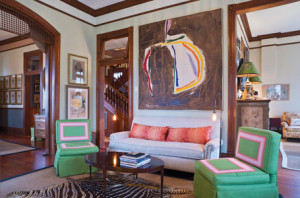 In the living room of the Davidsons’ home hangs the flag that draped his coffin, given to them by a close family friend. “We were told that the flag belonged here,” says Josephine. It hangs in a sleek, contemporary Lucite case etched with the words that were written in Cadet Brooks’ honor when his body was re-interred at Brooks Air Force Base. In juxtaposition, an oil on canvas by contemporary artist Kikuo Saito fills the space with fluidity and gestural sweeps of color that are both rhythmic and vibrant.
In the living room of the Davidsons’ home hangs the flag that draped his coffin, given to them by a close family friend. “We were told that the flag belonged here,” says Josephine. It hangs in a sleek, contemporary Lucite case etched with the words that were written in Cadet Brooks’ honor when his body was re-interred at Brooks Air Force Base. In juxtaposition, an oil on canvas by contemporary artist Kikuo Saito fills the space with fluidity and gestural sweeps of color that are both rhythmic and vibrant.
Massive pocket doors open to the connecting dining room, where a portrait of Josephine’s grandmother, Carolyn Brown Negley, holds court. Commissioned by her great-grandparents, British portrait artist Douglas Granville Chandor painted portraits of the Browns’ three children to hang in the family home, Oak Court, on Ivy Lane in Terrell Hills. “From the time that I was 12 years old, I wanted my grandmother’s portrait,” says Josephine.
The dining room fireplace mantel is flanked by a pair of antique urn-shaped mahogany knife boxes, while Texas artist Joey Fauerso’s video works that have been made into stills, hand-painted and degraded, surround the space. Fauerso took a trip to the Negley/Gill Swan Lake Ranch on the coast, riding on an airboat to capture some 200 abstract paintings she made of the river. She created a constantly shifting and changing video, Guadalupe-After Images, that comprises the Davidsons’ photographic collection.
Victor Pagona’s large-scale photograph of an animal skull consumes the spacious room. As professor of photography at the Southwest School of Art and chair of the photography department, Pagona created a camera that extended the depth of field to shoot the found object, allowing light to hit prominent sections of the skull and extracting minute detail.
A pair of 17th-century carved and polychromed Italian blackamoors that belonged to Josephine’s grandmother hold trays laden with crystal and silver liquor decanters. Purchased in New Orleans, these were her grandmother’s most cherished antiques. An exuberant assemblage of giant multicolored pinwheels sprouts from the dining room walls and spreads throughout the house. Innovative works by 14-year-old San Antonio artist Bygoe Zubiate, these paintings are executed on sheets of thick cardboard used to separate rolls of newsprint. Noted furniture maker and father of the promising young artist, Peter Zubiate fabricated a large spin art machine for his daughter to create ribbons of color on repurposed canvases.
In a hallway adjacent to the dining area, a Claude Venard abstract of the Sacré-Cœur Basilica painted in 1954 hangs over a bar set for entertaining. Just down the main hallway, a powder room is a repository of family portraits and photographs dating back to the Civil War. Going through a chest of drawers that once belonged to her grandmother, Josephine found dozens of family images resting in worn envelopes. Each is simply framed and hangs in a grouping offering wonderful glimpses of dinner parties, family outings, military careers and sittings for formal occasions. Photographer Debra Sugerman was commissioned to create a series of photographs of the Davidson children, continuing the photographic lineage of the family.
On the stairway to the upper floor, a massive pair of metal Negley Paint signs that were advertisement pieces from the 1930s hang in the stairwell on a hand-applied wallpaper that was Josephine’s inspiration and aptly executed by artists Ethel Shipton and Nate Cassie. “My color palette was inspired by a Kelly O’Connor painting, and the pattern was a collaboration between Ethel and Nate,” explains Josephine. A colorful composition depicts canine companions, including turquoise poodles, pink dachshunds, avocado bulldogs and taupe pointers, standing in their best Westminster form. Each vinyl piece was applied by hand, creating a patterned wall assemblage that is homage to popular wall texturing of the Victorian age.
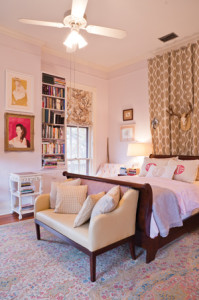 While performing utilitarian duty, family pieces hold places of significance in the children’s bedrooms. “When my mother was 6 or 7, my grandparents built their home in Terrell Hills,” recalls Josephine. “My grandmother (Carolyn Brown Negley) had phenomenal taste and was a great lover of contemporary art and architecture, yet my mother was less than impressed with the super-cool and modern bedroom furniture her mother had chosen for her.”
While performing utilitarian duty, family pieces hold places of significance in the children’s bedrooms. “When my mother was 6 or 7, my grandparents built their home in Terrell Hills,” recalls Josephine. “My grandmother (Carolyn Brown Negley) had phenomenal taste and was a great lover of contemporary art and architecture, yet my mother was less than impressed with the super-cool and modern bedroom furniture her mother had chosen for her.”
Enlisting Josephine’s great-grandmother Emily Wells Brown to step in, Josephine’s grandmother was persuaded to commission a four-poster canopied bed to be made for her mother. While visiting Paris, Mrs. Brown picked out a very feminine, very beautiful Pierre Frey fabric for the bed’s canopy and matching window valances. The bed, with its original fabric canopy and valances, now belongs to Josephine’s daughter. “I added the curtains to the bed and had them made when we were living in Houston,” she says. “They are a direct copy of curtains I saw on the cover of one of the first issues of Domino Magazine, and the designer said she had been inspired by an Oscar de la Renta dress. The woman who made them for me said that all that pinch pleating had nearly killed her and that she would never make them again!”
In the room shared by the Davidsons’ two young sons, a lacquered Chinese partners desk centers the room. It belonged to the children’s great-grandfather, Richard Gill. “After my grandmother Josephine Gill Hudson passed away in 2013, we unpacked her storage, which had a mind-bogglingly massive quantity of things, and that desk was amongst them,” Josephine recalls. “I had always known that I wanted a partners desk for them, and this one seemed destined to fall in my lap.” The desk, it seems, is yet another perfect example of how this family’s heirlooms and art join time and space.


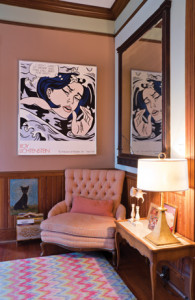





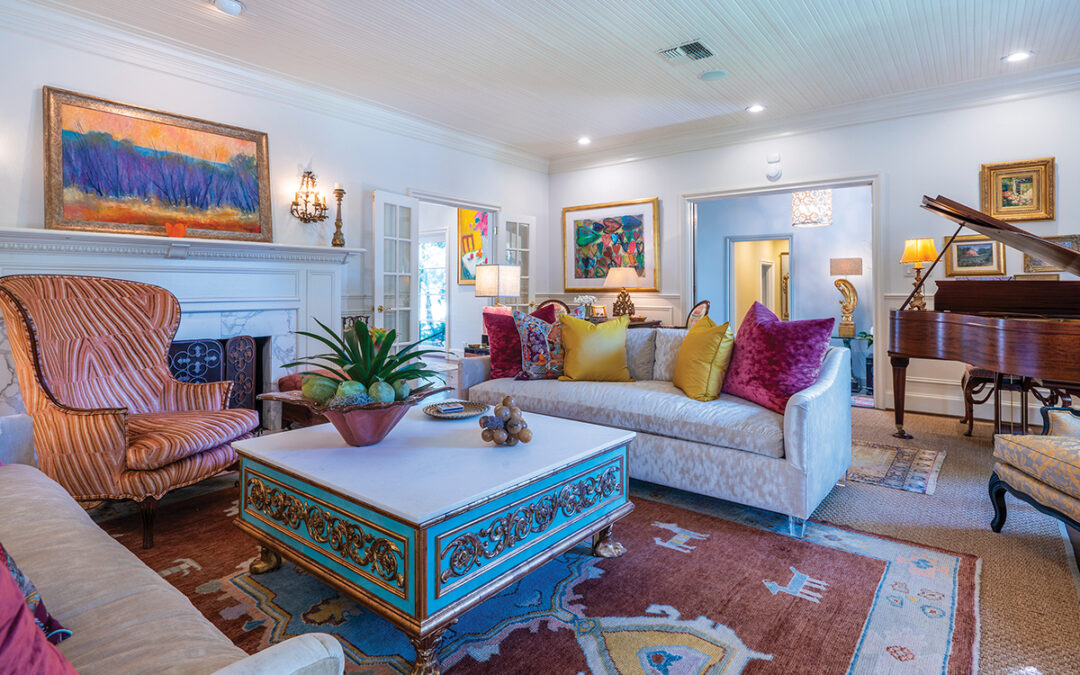
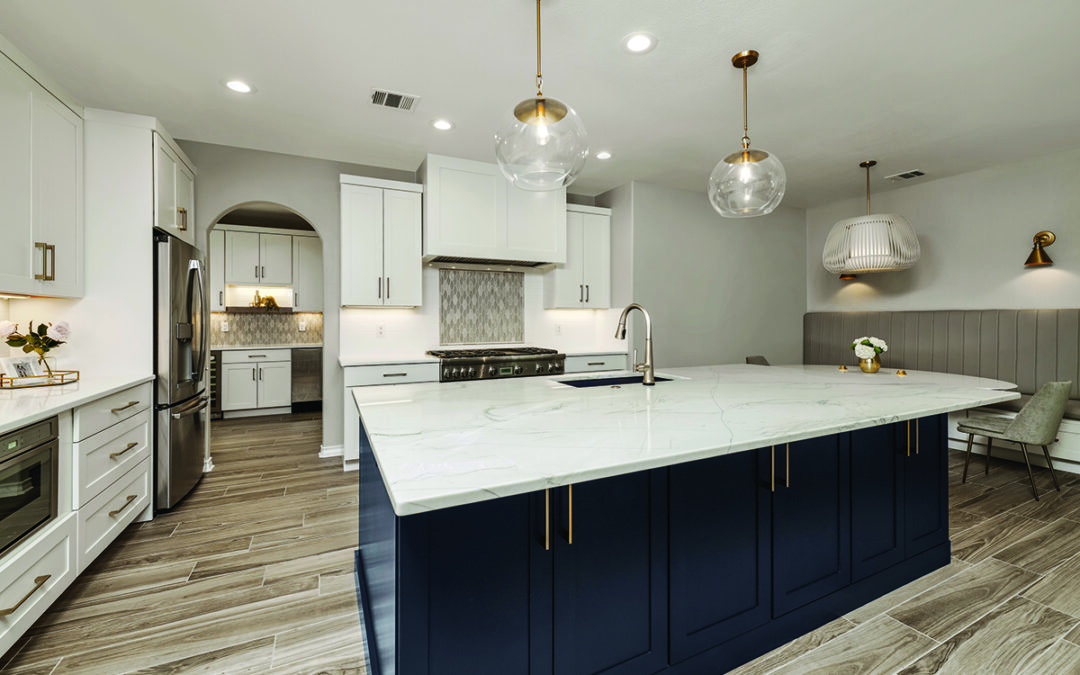
0 Comments